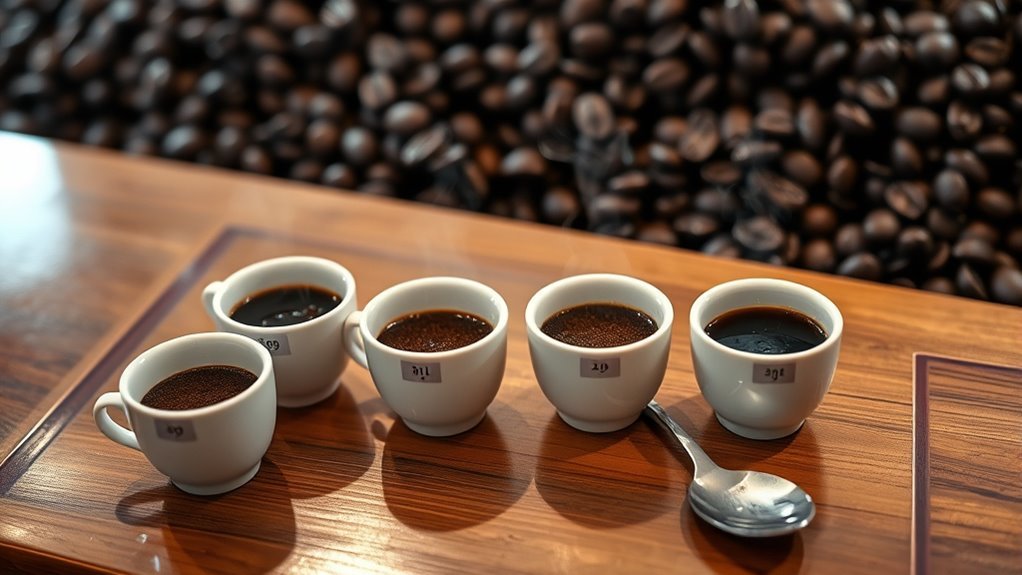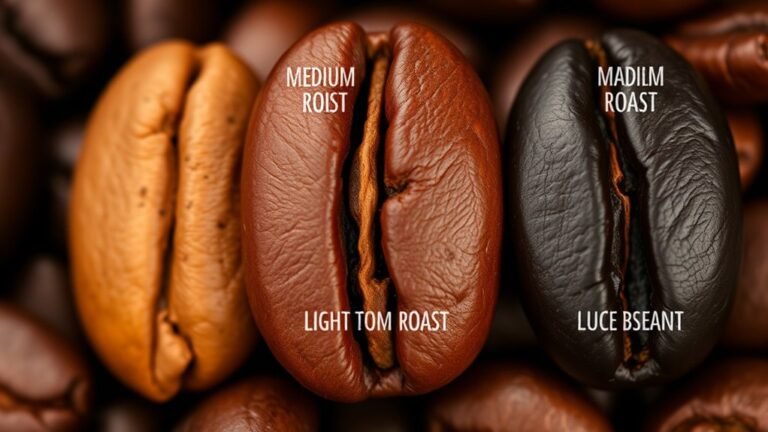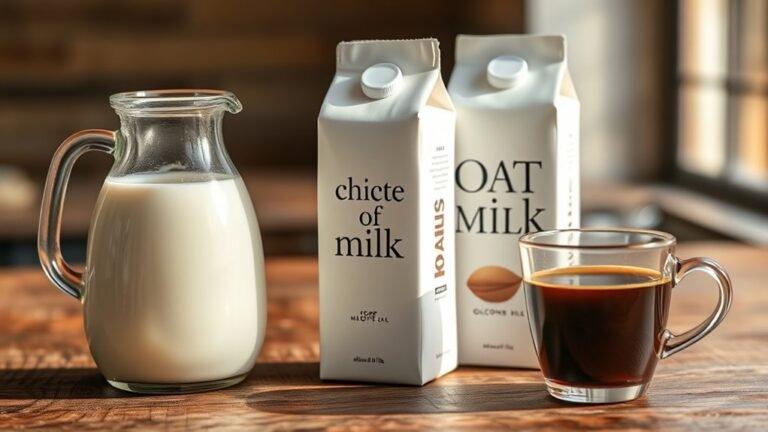How to Taste Coffee Like a Pro: A Guide to Cupping
To taste coffee like a pro, start with fresh, well-roasted single-origin beans ground just before cupping. Brew at about 200°F, then smell deeply to catch floral, fruity, or chocolate aromas. Break the crust and slurp to aerate, letting flavors spread across your palate to reveal acidity, body, and complex notes like citrus or spice. Take detailed notes on flavor, texture, and aftertaste, refining your palate with practice. Keep exploring to uncover the full story behind each cup.
Understanding the Basics of Coffee Cupping
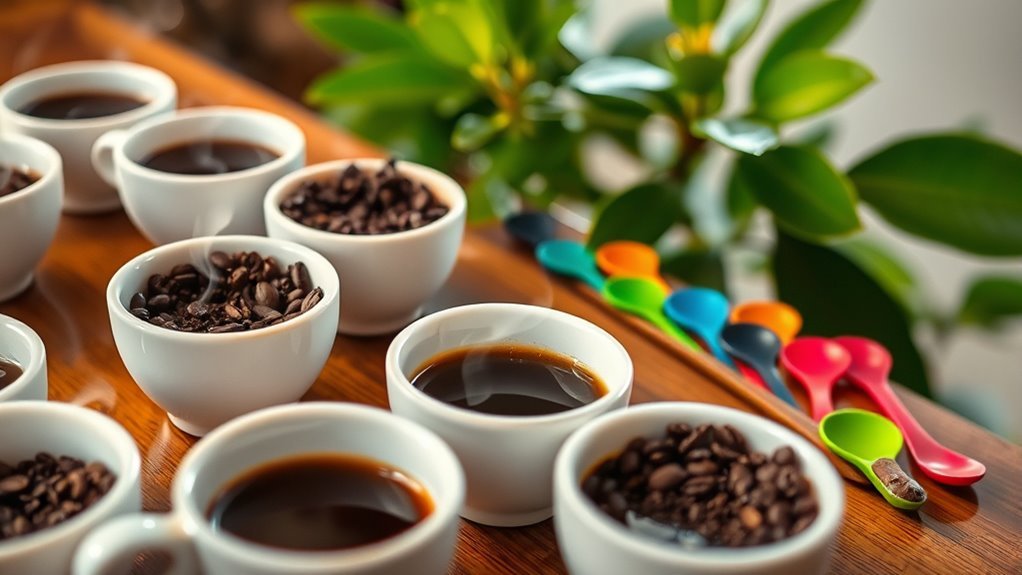
Before you plunge into the world of coffee tasting, it’s essential to grasp the basics of coffee cupping—a systematic method used by professionals to evaluate the aroma and flavor profiles of coffee beans. When you cup coffee, you’re not just drinking; you’re dissecting its character. Each coffee origin offers a unique story—from fruity Ethiopian beans to earthy Sumatran ones. You’ll learn to identify key tasting terminology: acidity, body, sweetness, and aftertaste. As the hot grounds release their aroma, your senses awaken to subtle floral notes or hints of chocolate. You’ll break the crust with a spoon, releasing a burst of fragrance. This process frees you to explore coffee’s complex flavors without distraction, sharpening your palate and deepening your appreciation for each cup’s distinct essence.
Selecting and Grinding Your Coffee Beans
Now that you’ve trained your senses to recognize the nuanced aromas and flavors during coffee cupping, the next step is choosing the right beans and preparing them properly. Start by selecting beans with a clear bean origin, as this profoundly shapes the flavor profile you’ll explore. Whether it’s the bright acidity of Ethiopian beans or the earthy tones of Sumatran, knowing the origin lets you anticipate and appreciate complexity. Next, consider the roast level—light roasts preserve origin characteristics and highlight floral or fruity notes, while darker roasts bring out deeper, smoky undertones. For cupping, freshness is key, so pick beans roasted within the past two weeks. Grinding should be precise and uniform, ideally just before cupping, to reveal the full spectrum of aromas and flavor nuances without bias or interference.
Preparing the Coffee for Cupping
You’ll want to start by choosing fresh, high-quality beans that showcase distinct flavors. Grinding them to a consistent medium-coarse texture guarantees even extraction and clarity in your cup. Then, carefully control your water temperature around 200°F to reveal the coffee’s true aromatic and taste profile.
Selecting Coffee Beans
Although selecting coffee beans might seem straightforward, the process demands a keen attention to detail and an understanding of how bean quality influences flavor. You’ll want to choose single origin beans to fully appreciate unique regional characteristics—from bright citrus notes to deep chocolate undertones. Pay close attention to roast levels: lighter roasts preserve origin flavors with vibrant acidity, while medium to darker roasts develop richer, bolder profiles. Opt for freshly roasted beans, ideally within two weeks of roasting, to capture peak aroma and complexity. Inspect the beans’ uniformity and avoid defects that can skew tasting results. By selecting thoughtfully, you’re setting the stage to explore coffee’s nuanced spectrum freely, allowing your palate to uncover every subtle and vibrant note during cupping.
Grinding Consistency
Once you’ve selected the perfect beans, the next step is to grind them with exacting consistency to release their full flavor potential. The grind size must be precise—too coarse, and the flavors won’t extract fully; too fine, and bitterness creeps in. Equally important is grind uniformity, which guarantees each particle extracts evenly, revealing subtle notes and textures.
| Grind Size | Grind Uniformity | Flavor Outcome |
|---|---|---|
| Coarse | Low | Weak, underdeveloped |
| Medium-Fine | Medium | Balanced, smooth |
| Fine (Cupping) | High | Bright, fully expressed |
Water Temperature Control
While grinding consistency sets the stage, controlling water temperature during brewing brings out the nuanced flavors that define a coffee’s character. You want to aim for water temperature between 195°F and 205°F—this range guarantees ideal brewing, releasing a balanced extraction without bitterness or sourness. Too hot, and the coffee can taste burnt; too cool, and you’ll miss the brightness and depth. Use a precise thermometer or a reliable kettle with temperature control to maintain this sweet spot. As you pour, notice how the water’s heat interacts with the grounds, coaxing out floral notes, caramel sweetness, or a hint of citrus. Mastering water temperature lets you savor the coffee’s true essence and grants you the freedom to explore its full sensory spectrum during cupping.
Evaluating the Aroma and Fragrance
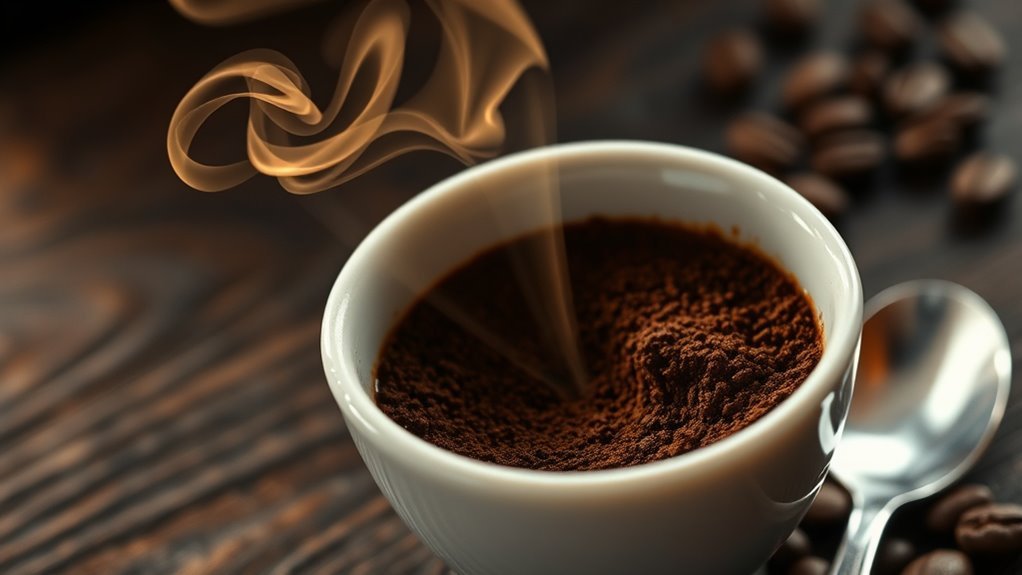
Aroma is your first gateway to experiencing coffee’s complexity, revealing notes that range from floral and fruity to nutty and spicy. As you lean in, take a slow, deliberate sniff to capture the full spectrum of aromatic compounds. These volatile molecules are the essence of coffee’s character, unveiling subtle hints of jasmine, citrus, or even cocoa. During sensory evaluation, pay attention to the intensity and balance of these scents. Are they vibrant or muted? Do they evolve as you breathe? This olfactory journey sets the stage for tasting, sharpening your awareness and preparing your palate. By focusing on fragrance, you’re not just smelling coffee—you’re immersing yourself in its story, liberating your senses to explore every nuanced layer hidden within each cup.
Tasting and Slurping Techniques
When you slurp coffee, it’s essential to draw air and liquid simultaneously to spread the flavors evenly across your palate. This technique helps release subtle notes and textures you might otherwise miss, enhancing your ability to recognize the coffee’s aroma and mouthfeel. Mastering these steps sharpens your sensory awareness, making each sip a more vivid experience.
Proper Slurping Method
Before you even take your first sip, mastering the proper slurping technique is essential to fully reveal the coffee’s flavor profile. Slurping techniques aren’t just for show—they actively aerate the coffee, spreading it evenly across your palate. To do it right, draw in a sharp, controlled stream of coffee through your front teeth, creating a distinct slurping sound. This sound importance lies in the fact that it signals you’re pulling in air alongside the liquid, which enhances flavor perception and helps identify subtle notes. Don’t be shy; embrace the noise as part of the sensory experience. By perfecting this method, you’ll uncover layers of aroma and taste, making your coffee tasting freer, fuller, and truly immersive.
Flavor Extraction Tips
Although slurping is key, fully extracting and appreciating coffee’s complex flavors also depends on how you taste and interact with the brew. Your tongue needs to embrace the coffee’s diverse flavor profiles, allowing extraction methods to reveal subtle notes. When you slurp, you oxygenate the liquid, spreading it across your palate and enhancing perception.
| Extraction Method | Impact on Flavor Profiles | Tasting Tip |
|---|---|---|
| Full immersion | Rich, balanced sweetness | Slurp deeply, roll coffee around |
| Pour-over | Clean, bright acidity | Sip slowly, focus on brightness |
| Espresso | Intense, concentrated flavors | Small sips, note bitterness |
| Cold brew | Smooth, mellow | Let flavors linger, savor calm |
Master these techniques, and you’ll gain the freedom to taste coffee like a pro.
Aroma and Texture Recognition
Aroma acts as the gateway to coffee’s full sensory experience, drawing you in with its intricate bouquet before a single sip. Begin by inhaling deeply to assess aroma intensity, noting floral, fruity, or earthy notes that define the coffee’s character. This moment reveals subtle complexities your palate will soon explore.
Next, master the art of slurping to maximize texture evaluation. Draw the coffee rapidly into your mouth, aerating it to spread flavors evenly across your tongue. Focus on how the liquid feels—silky, creamy, or coarse—and how it coats your palate. Texture shapes flavor perception, influencing your overall experience. Through mindful aroma and texture recognition, you gain the freedom to truly understand and appreciate every nuanced layer of your coffee.
Identifying Flavor Notes and Profiles
Flavor notes are the distinct tastes and sensations that reveal themselves as you sip your coffee, helping you understand its complexity and origin. When you take a moment to truly taste, you’ll notice layers—perhaps hints of citrus, chocolate, or floral sweetness. Using a flavor wheel can guide you in pinpointing these tasting notes accurately, breaking down broad categories into specific descriptors. Focus on the balance and intensity of these flavors, how acidity, bitterness, and sweetness interplay on your palate. Each coffee tells a unique story through its profile, shaped by factors like region and roast. As you refine your palate, you’ll gain the freedom to explore and appreciate the endless variety in every cup.
Recording Your Observations and Scores
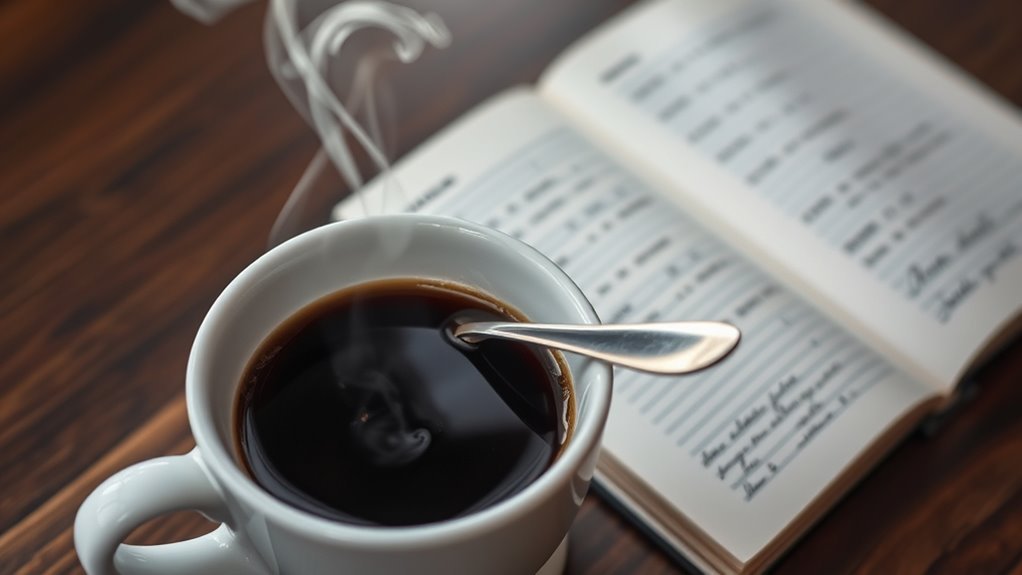
Once you’ve identified the subtle layers and unique characteristics of your coffee, capturing these impressions clearly will deepen your tasting experience. Use refined observation techniques to note aroma, acidity, body, flavor, and aftertaste, focusing on precise sensory details. Record your scores using established scoring criteria, assigning values that reflect the intensity and quality of each attribute. Keep your notes structured but flexible—this lets you express the coffee’s personality without constraints. By combining objective scoring with personal observation, you create a vivid, reliable profile that informs future tastings and selections. This disciplined yet free approach guarantees your evaluations remain consistent, insightful, and true to the coffee’s essence, giving you the freedom to trust your palate and refine your preferences confidently.
Frequently Asked Questions
What Equipment Is Essential for Professional Coffee Cupping?
Ever wondered what gear you need to truly savor coffee’s nuances? You’ll want cupping bowls to hold your samples, allowing you to observe aroma and color effortlessly. Tasting spoons are essential too—they help you slurp the brew evenly, spreading flavors across your palate. These tools let you reveal coffee’s intricate profiles, freeing your senses to explore every note, from bright acidity to deep earthiness, making your tasting experience both precise and liberating.
How Often Should Coffee Cupping Sessions Be Conducted?
You’ll want to follow frequency recommendations that suit your goals—weekly sessions work well if you’re honing your palate, while bi-weekly might suffice for casual tasting. Each session’s duration should be about 45 minutes to an hour, giving you enough time to savor aromas, note flavors, and let your senses fully engage. This rhythm lets you explore coffee’s nuances freely, without feeling rushed or overwhelmed.
Can Water Quality Affect the Coffee Cupping Results?
Absolutely, water quality plays a huge role in your coffee cupping results. If the water has high hardness, it can mute delicate flavors or introduce unwanted bitterness, masking the coffee’s true character. Using proper filtration systems helps you control mineral content, letting the coffee’s aroma and nuanced tastes shine. When you free yourself from poor water, your palate experiences each sip’s clarity and complexity, revealing the coffee’s genuine essence without distractions.
What Are Common Mistakes to Avoid During Coffee Cupping?
Don’t let your coffee cupping experience slip through your fingers like sand—avoid common mistakes to savor every note. Over brewing coffee can drown delicate flavors, while ignoring aroma means missing half the story. You’ve got to breathe in deeply, letting scents guide your palate. Also, don’t rush the process; take your time to notice subtle textures and tastes. Precision and patience will set your senses free to truly enjoy each cup.
How Do Professional Cuppers Train Their Palate?
To train your palate like professional cuppers, you’ll engage in consistent palate development through sensory evaluation. This means tasting a wide variety of coffees, noting subtle flavor differences and aromas. You’ll practice identifying acidity, body, and aftertaste with focused attention, refining your sensory skills. Over time, your taste buds become more sensitive and discerning, allowing you to enjoy coffee with freedom and precision, revealing layers you never noticed before.
